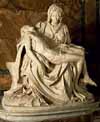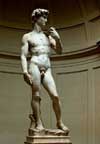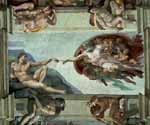Michelangelo Buonarroti was born in Caprese, in the Val Tiberina, on 6th March 1475.
 His family was one of the lesser noble families and this allowed Michelangelo to attend Domenico Ghirlandaio’s school, although he never liked the man. A workshop did not suit Michelangelo who liked to work on his own. In these years he studied Florentine XV century arts and the works of painters like Filippo Lippi, Gentile da Fabriano, Verrocchio, Pollaiolo and especially Masaccio. After a year in Ghirlandaio’s workshop, Michelangelo left for the garden of the Medici family, where there was a collection of works of art, many old medallions and cameos. Here famous Italians met, including Angelo Poliziano, Pico della Mirandola and Marsilio Ficino. Here the artist’s idea of art’s beauty was born: for Michelangelo (as for other Renaissance artists) art is the imitation of nature and by studying nature beauty is achieved in art. Unlike other artist Michelangelo did not believe in representing nature as closely as possible; he preferred to look at the best parts of nature and create beauty which was superior to nature’s beaty.
His family was one of the lesser noble families and this allowed Michelangelo to attend Domenico Ghirlandaio’s school, although he never liked the man. A workshop did not suit Michelangelo who liked to work on his own. In these years he studied Florentine XV century arts and the works of painters like Filippo Lippi, Gentile da Fabriano, Verrocchio, Pollaiolo and especially Masaccio. After a year in Ghirlandaio’s workshop, Michelangelo left for the garden of the Medici family, where there was a collection of works of art, many old medallions and cameos. Here famous Italians met, including Angelo Poliziano, Pico della Mirandola and Marsilio Ficino. Here the artist’s idea of art’s beauty was born: for Michelangelo (as for other Renaissance artists) art is the imitation of nature and by studying nature beauty is achieved in art. Unlike other artist Michelangelo did not believe in representing nature as closely as possible; he preferred to look at the best parts of nature and create beauty which was superior to nature’s beaty.
 In 1496 he left Florence and moved to Rome, where cardinal Jean Bilheres commissioned the Pietà. The work of sculpture shows the Madonna with a lifeless Christ in her arms. For Michelangelo the art of sculpture was a special art which allowed the artist to free the figures which were trapped in the marble block. For this reason he considered carving stone “a way of removing” splinters of marble from the block.
In 1496 he left Florence and moved to Rome, where cardinal Jean Bilheres commissioned the Pietà. The work of sculpture shows the Madonna with a lifeless Christ in her arms. For Michelangelo the art of sculpture was a special art which allowed the artist to free the figures which were trapped in the marble block. For this reason he considered carving stone “a way of removing” splinters of marble from the block.
In 1501 he was back in Florence and received a commission for a statue of David which was to be placed in the duomo. He was given a block of marble previouslyused by Agostino di Duccio.
The statue is of David in the instant before throwing the stone: tension and concentration are clearly visible in the tensed muscles and bulging veins. The statue was placed in front of Palazzo Vecchio; it is now in the Accademia of Belle Arti and a copy was been put in its place.
In Florence he painted a plate with the Holy Family for the wedding of Agnolo Doni; the plate is known as Tondo Doni. The bodies’ iridescent colours are like statues; in the fore ground is the Holy Family and behind them, on a low wall, is St Giovannino. Behind the latter, in the background, there are naked young men, considered precursors of Prisons (painted in the mausoleum of Julius II).
In 1503 Michelangelo went back to Rome where Pope Julius II della Rovere commissioned his mausoleum; the artist worked on it from 1503 to 1545.
 In 1508 he received a commission for the frescos of the Sistine Chapel (he worked on them till 1512).
In 1508 he received a commission for the frescos of the Sistine Chapel (he worked on them till 1512).
The vault is decorated with false architecture and the pendentives show Judith and Olophernes, David and Goliath, the Brazen Serpent and the Punishment of Amon. The lower part of the vault is decorated with Prophets and Sybils. The central part is divided into nine parts, separated by arches, marble frames and bronze medallions depicting scenes from the Bible, with the Creation of Adam in the central part.
Shortly after the death of Julius II Michelangelo finished carving the Rebel Slave, the Dying slave and Moses in St Peter in Chains.
The new Pope, Leo X, sent Michelangelo to Florence to complete the façade of St Lorenzo and to build the New Sacristy, the Library and the Tombs of the Medici (for these he carved the statues of Day and Night).
In 1534 he settled in Rome permanently and accepted the commission for painting the Last Judgement in the Sistine Chapel.
After Bramante’s death a number of architects tried to end the project of St Peter’s and in 1547 Paul III gave Michelangelo the task. The architect worked on the apse but the building was completed after his death, with the construction of the dome he had designed (which was probably modified).
His last work is Pietà Rondanini, which he did not finish and is today in the Sforza Castle in Milan.
Michelangelo Buonarroti died on 18th February 1564 in Rome, in his house near Trajan’s Forum.
Michelangelo Buonarroti, Rime
Che giova voler far tanti bambocci, se mi ha condotto al fin, come colui che passò '1 mar e poi affogò ne mocci? L'arte pregiata, ov'alcun tempo fui di tanta opinion, mi rec'a questo, povero, vecchio e servo in forz'altrui chio son disfatto, si'non muoio presto.
Non ha l'ottimo artista alcun concetto c'un marmo solo in sé non circonscriva col suo superchio, e solo a quello arriva la man che ubbidisce all'intelletto. Il mal ch'io fuggo, e '1 ben ch'io mi prometto.
in te, donna leggiadra. altera e diva, tal si nasconde; e perch'io più non viva, contraria ho l'arte al disiato effetto. Amor dunque non ha, né tua beltate o durezza o fortuna o gran disdegno del mio mal colpa, o mio destino o sorte; se dentro del tuo cor morte e pietate porti in un tempo, e che '1 mio basso ingegno
non sappia, ardendo, trarne altro che morte.
Se con lo stile o coi colori avete alla natura pareggiato l'arte, anzi a quella scemato il pregio in parte, che '1 bel di lei più bello a noi rendete poi che con dotta man posto vi sete a più degno lavoro, a vergar carte, quel che vi manca, a lei di pregio in parte, nel dar vita ad altrui, tutta togliete. Che se secolo alcuno omai contese in far bell'opre, almen cedale, poi che convien c'al prescritto fine arrive. Or le memorie altrui, già spente, accese tornando, fate or che fien quelle e voi, malgrado d'esse, etternalmente vive.
Vasari, Le vite de' più eccellenti pittori, scultori et architetti
Desiderava Michelagnolo ritoccare alcune cose a secco, come avevon fatto que' maestri vecchi nelle storie di sotto, certi campi e panni ed arie di azzurro oltramarino ed ornamenti d'oro in qualche luogo. acciò gli desse più ricchezza e maggior vista:
perché, avendo inteso il papa che ci mancava ancor questo, desiderava, sentendola lodar tanto da chi l'aveva vista, che la fornissi; ma, perché era troppo lunga cosa a Michelagnolo rifare il palco, restò pur così. Il papa, vedendo spesso Michelagnolo, gli diceva: Che la cappella si arricchisca di colori e d'oro, che l'è povera. Michelagnolo con domestichezza rispondeva: Padre Santo in quel tempo gli uomini non porzavano addosso oro, e quegli che son dipinti non furon mai troppo ricchi, ma santi uomini, perché gli sprezzarono le ricchezze. Fu pagato in più volte a Michelagnolo dal papa, a conto di quest'opera, tremila scudi, che ne dovette spendere in colori venticinque. Fu condotta questa opera con suo grandissimo disagio dello stare a lavorare col capo allinsù, e talmente aveva guasto la vista, che non poteva legger lettere, nè guardar disegni se non allinsù: che gli durò poi parecchi mesi. Ed io ne posso fare fede, che avendo lavorato cinque stanze in volta per le camere grandi del palazzo del duca Cosimo, se io non avessi fatto una sedia che s'appoggiava la testa e si stava a giacere lavorando, non le conducevo mai; che mi ha rovinato la vista ed indebolito la testa di maniera, che me ne sento ancora; e stupisco che Michelarnolo regessi tanto a quel disagio. Imperò acceso ogni dì più dal desiderio del fare, ed allo acquisto e miglioramento che fece, non sentiva fatica né curava disagio